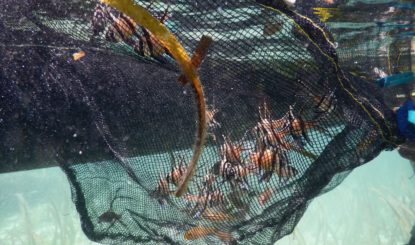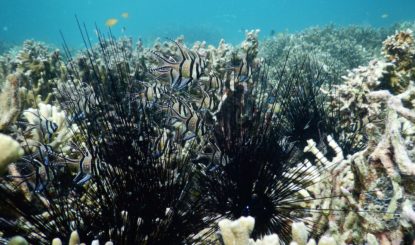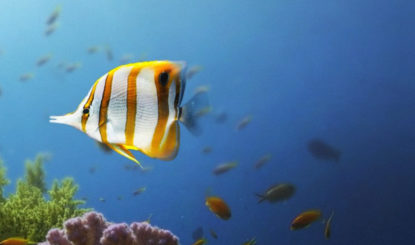The Impact to Reefs of The Trade in Marine Ornamental Fishes
Our marine biologist Dr. Monica V. Biondo summarizes the latest findings of her research about the global trade in marine ornamental fishes in the December Issue of «Reef Encounter», the news magazine of the International Coral Reef Society (ICRS).
Access the original version of this article (PDF) here (page 44 onwards).
Marine ornamental fishes, primarily fishes from coral reefs, are caught for private and public aquaria. The business has grown strongly over the last two decades and is now worth 1.5 billion US$ (Wabnitz et al. 2003; Smith et al. 2008; Monticini 2010; Rhyne et al. 2012, 2017; Dee et al. 2014; Leal et al. 2015; Biondo 2017), so that despite past measures taken to regulate the industry the fishery represents a real threat to reef communities, albeit less significant than that posed by climate change. Currently around 2,300 species and annually about 40 million specimens are estimated to be traded worldwide (Rhyne et al. 2017; Stevens et al. 2017).This figure does not include mortality in the supply chain, which represents a major concern (Wabnitz et al. 2003; Vagelli 2011; Stevens et al. 2017). In some places the trade directly threatens the species concerned, due to poor handling during capture and transportation, or to damage to the ecosystem resulting from unsustainable capture practices, such as the illegal use of cyanide in Southeast Asia (Vagelli 2011; Cohen et al. 2013;). Most ornamental fishes seem to be sold to the USA, Europe and Japan (Wabnitz et al. 2013). For Asia, Africa, Central and South America, however, there are hardly any data available.
Since few coral reef fishes are bred in captivity, the majority come from the wild (Wabnitz et al. 2003; Rhyne et al. 2012, 2017; Biondo 2017, 2018; Biondo and Burki 2019). The Food and Agriculture Organization of the United Nations (FAO) and the World Association of Zoos and Aquariums (WAZA) state that only 25 marine ornamental fish species are being captive bred in commercial numbers (Bartley 2005; Penning et al. 2009). A 2013 list of captive bred marine ornamental fishes published by the Marine Breeders Association (MBA) lists 15 species, while 29 species of captive bred species were readily available in the US in 2015 and 27 in 2016 (Sweet 2014, 2016b). However, there are reports of between 100 and 330 species of marine ornamental fish having been bred in captivity, largely on a hobbyist or research scale. Of these, approximately 30–35 species are currently in commercial production, albeit still on a relatively small scale (Fotedar and Phillips 2011; Sweet 2016b).
Tangible trade data are only collected for species that are listed on the Appendices of the Convention on International Trade of Endangered Species of Fauna and Flora (CITES; www.cites.org). Thus, there is no monitoring of the trade for virtually any coral fishes, except seahorses (Hippocampus spp.), the clarion angel fish (Holacanthus clarionensis) and the napoleon wrasse (Cheilinus undulatus) (see illustration on p 48), for which trade is regulated by CITES. Historically, scientists have pointed out the importance of accurate trade statistics , but so far only a handful of studies have attempted to quantify this global trade (Wabnitz et al. 2003; Rhyne et al. 2012, 2017; Biondo 2017, 2018; Biondo and Burki 2019). Europe is a major importer of coral reef fishes and uses the Trade Control and Expert System (TRACES) to monitor trade in live animals for disease prevention purposes. Similarly, the US monitor this trade using the Law Enforcement Management Information System (LEMIS), (LEMIS 2009; Rhyne et al. 2017). Neither data collection systems are intended to record species-specific information on marine ornamental fishes, but rather they record numbers of traded specimens. However, TRACES collects information on species to at least family level. Consequently, it is possible to estimate the volume of trade, and to some extent also families and species traded, into Europe. Studies done for Switzerland from 2014 to 2017 showed that about 50,000 specimens were traded to Switzerland annually and that the species came from 19 countries and were also trans-shipped to 11 EU countries (Biondo 2018).
The trade for the whole of Europe was found to amount to approximately 4 million marine ornamental fishes per year during the period 2014 and 2017 (Biondo and Burki, 2019). Between 2014 and 2017, fish species from 86 families were imported to Europe. The top 10 families made up 90% of the fish in terms of number of specimens.
For data from Europe, especially susceptible species were identified using the number of traded specimens, trends in the trade volume, and IUCN Red List conservation status, as well as vulnerability according to FishBase. After normalization of data a score was created to generate a watchlist that indicates overall susceptibility to overexploitation of the species concerned (Biondo and Burki 2019). Unfortunately, however, almost a third of species listed were found to be data deficient or not evaluated by the IUCN Red List and so could not be included in these calculations (Biondo 2018; Biondo and Burki 2019).
In previous decades, various initiatives were introduced with a view to regulating the international ornamental fish trade, but these efforts have had only limited success. The Marine Aquarium Council (MAC) label was established in 1998 to ensure traceability, good practices, and sustainable schemes of ecologically and socially responsible fishing, but has been inactive since 2008 (UNEP 2009). The Global Marine Aquarium Database (GMAD) launched in 2002 was intended to collect accurate trade data, but voluntary data entry ceased after one year due to lack of funding (Townsend 2011; Murray et al. 2012). Also, the EU commissioned consultancy study on improving trade statistics for EU imports of tropical marine fishes (UNEP-WCMC 2008) has not resulted in any action since the report’s submission.
As a result of the available research in August 2019 Switzerland, the European Union and the USA submitted to CITES CoP18, (in Geneva, Switzerland) a proposal to investigate the international trade in marine ornamental fishes in preparation for the next conference in 2022 (https://cites.org/sites/default/files/eng/cop/18/doc/E-CoP18-094.pdf). The over 180 member states represented recognised the urgency of the situation and approved the proposal by consensus. From now until the next Animals Committee meeting, which will take place in the summer of 2020, the first steps in this investigation need to be agreed and acted upon. The principal aim of the work will be to determine which species need to be listed in the Appendices of CITES, under the terms of which their trade can be monitored and research conducted to determine if this is having detrimental effects on the species. Subsequently it may well be necessary to restrict or ban the trade in certain species, but it is a concern that this will likely take 8 years or more to achieve.
The original version of this article has first been published in the December 2019 issue of «Reef Encounter» (page 44 onwards), the news magazine of the International Coral Reef Society (ICRS).
Further information:



